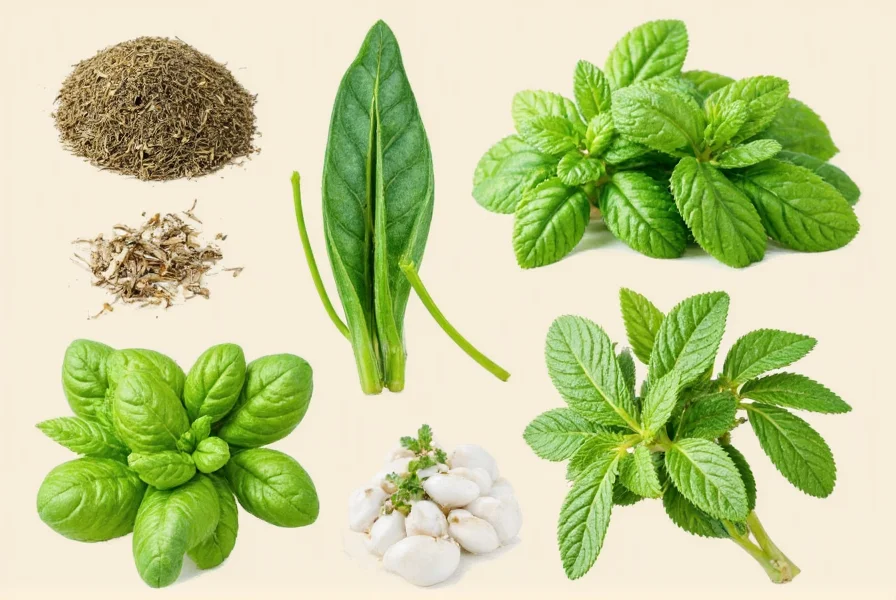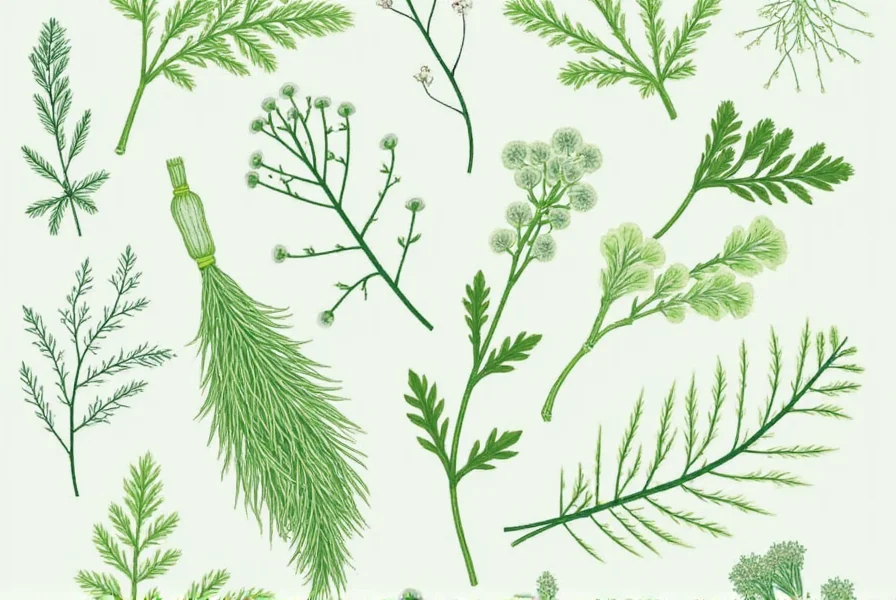Top 10 Most Common Cooking Herbs
Basil
Aromatic, sweet, and slightly peppery, basil is the star of Italian cuisine. It shines in pesto, tomato sauces, and fresh salads. Fun fact: It's one of the few herbs best used fresh rather than dried.

Parsley
Often relegated to garnish status, parsley is so much more than decoration. With a bright, clean flavor, it livens up sauces, soups, and stews. There are two main types: curly and flat-leaf (also called Italian parsley). Flat-leaf has a stronger flavor and is easier to chop.
Cilantro
You either love it or hate it—and some people swear it tastes like soap! Cilantro, or coriander leaf, is essential in Mexican, Indian, and Southeast Asian cuisines. It's got a fresh, citrusy note that pairs beautifully with lime, chilies, and avocado.
Thyme
Mellow, earthy, and slightly minty, thyme is a workhorse herb. Its small leaves cling tightly to woody stems, making it perfect for long-cooked dishes like roasts, stews, and braises. Lemon thyme is a delicious variation that adds a citrusy twist.
Rosemary
Fragrant, pine-like, and super potent, rosemary adds bold flavor to roasted meats, potatoes, and breads. A little goes a long way—especially when using fresh sprigs. Pro tip: Crush or chop it before adding to release the oils.
Oregano
The backbone of Mediterranean and Mexican cooking, oregano is warm, bitter, and robust. Dried oregano actually holds its flavor better than fresh, making it a staple for tomato sauces, pizzas, and grilled veggies.
Sage
If herbs had a personality, sage would be wise and strong. It's earthy, slightly peppery, and wonderful in stuffing, sausage, and butter-based sauces. Often paired with fatty meats like pork or duck, sage brings out the richness beautifully.
Mint
Fresh, cooling, and vibrant, mint is more than just a garnish for mojitos. Peppermint and spearmint are popular varieties. Use it in teas, desserts, lamb dishes, and Middle Eastern salads like tabbouleh.
Chives
Mild, oniony, and grassy, chives bring a gentle kick without overpowering a dish. Snip them over baked potatoes, eggs, or dips for a pop of color and flavor. They don't hold up well to heat, so always add them at the end.
Dill
Bright, feathery, and slightly tangy, dill is a must-have for pickling, fish dishes, and creamy sauces. Its unique flavor complements cucumbers and salmon perfectly. Like basil, dill is best used fresh.

| Herb | Flavor Profile | Best For | Fresh or Dried? |
|---|---|---|---|
| Basil | Sweet, peppery, aromatic | Pesto, pasta, caprese salad | Fresh |
| Parsley | Bright, fresh, mild | Garnish, soups, sauces | Fresh or dried |
| Cilantro | Citrusy, sharp, divisive | Salsas, curries, tacos | Fresh |
| Thyme | Earthy, woodsy, minty | Stews, roasts, marinades | Fresh or dried |
| Rosemary | Piney, resinous, intense | Roasted meat, potatoes, focaccia | Fresh or dried |
| Oregano | Warm, bitter, savory | Pizza, pasta, grilled vegetables | Dried |
| Sage | Woody, earthy, pungent | Stuffing, sausages, butter sauces | Fresh or dried |
| Mint | Cooling, sweet, refreshing | Teas, desserts, lamb | Fresh |
| Chives | Oniony, delicate, crisp | Eggs, potatoes, dips | Fresh |
| Dill | Tangy, grassy, aromatic | Pickles, fish, yogurt sauces | Fresh |
Buying Guide: How to Choose the Best Herbs
Fresh vs. Dried Herbs: What's the Difference?
- Fresh herbs: More vibrant, aromatic, and delicate. Ideal for finishing dishes or adding brightness. Examples: basil, cilantro, dill, chives.
- Dried herbs: More concentrated and shelf-stable. Better for slow-cooked dishes where they can rehydrate. Examples: oregano, thyme, rosemary.
Where to Buy Herbs
- Grocery stores: Most supermarkets carry basic herbs like parsley, basil, and cilantro. Look for firm stems and vibrant green leaves.
- Farmers markets: Best for seasonal, locally-grown herbs with peak freshness and flavor.
- Online retailers: Great for specialty herbs or dried herb collections that might not be available locally.
- Grow your own: The freshest option—start with pots of basil, mint, or parsley on your windowsill.
Features to Look For
- No wilting or yellowing leaves
- Firm stems and no sliminess
- Strong aroma when rubbed
- No mold or brown spots
Storage Tips: Keep Your Herbs Fresh Longer
Storing Fresh Herbs
- Wrap soft herbs like basil and cilantro in a damp paper towel and place them in a plastic bag in the fridge.
- For longer life, treat basil like a bouquet of flowers: stand it upright in a glass of water at room temperature.
- Freeze chopped herbs in ice cube trays with a bit of oil or water for easy future use.
- Hang woody herbs like rosemary and thyme upside down in a dry, ventilated area to dry naturally.
Storing Dried Herbs
- Store in airtight containers away from light and heat.
- Replace every 6–12 months for optimal potency.
- Grind whole leaves just before use for maximum flavor.
Cooking with Herbs: When and How to Use Them
When to Add Fresh Herbs
- Right before serving (e.g., basil in a soup)
- At the very end of cooking (e.g., chives sprinkled on a baked potato)
- As a garnish (e.g., cilantro on tacos)
When to Add Dried Herbs
- Early in the cooking process (e.g., thyme in a braise)
- During marinating (e.g., rosemary in grilled chicken rubs)
- In slow-cooked dishes (e.g., oregano in chili or tomato sauce)
Frequently Asked Questions About Cooking Herbs
What's the main difference between fresh and dried herbs?
Fresh herbs have a brighter, more delicate flavor and are ideal for finishing dishes or adding at the end of cooking. Dried herbs are more concentrated, shelf-stable, and better for long-cooking dishes where they can rehydrate. As a general rule, use 1 part dried herb for every 3 parts fresh herb.
Which herbs are easiest to grow at home for beginners?
Basil, mint, chives, and parsley are among the easiest herbs to grow at home. They adapt well to container gardening and require minimal maintenance. Rosemary and thyme are also good options as they're drought-tolerant once established.
How can I tell if my fresh herbs have gone bad?
Fresh herbs have gone bad when they become slimy, develop black spots, lose their vibrant green color, or emit a sour or musty smell. A simple test: if they don't spring back when gently squeezed, they're past their prime.
Can I substitute dried herbs for fresh in recipes?
Yes, but with caution. The general conversion is 1 teaspoon of dried herbs for every 1 tablespoon of fresh herbs. Keep in mind that some herbs (like basil, cilantro, and dill) lose significant flavor when dried and are best used fresh for optimal taste.
Which herbs pair best with chicken?
Thyme, rosemary, sage, and tarragon work exceptionally well with chicken. For lighter preparations like grilled chicken, try dill or tarragon. For roasted chicken, rosemary and thyme create beautiful aromatics. Sage pairs wonderfully with chicken in creamy sauces or stuffings.
What's the best way to chop herbs to preserve their flavor?
Use a sharp chef's knife on a clean cutting board. For delicate herbs like basil and cilantro, a chiffonade cut (stacking leaves and slicing thinly) works well. For woody herbs like rosemary, mince finely. Always chop just before using, as cut herbs lose flavor quickly. Never use a food processor for most herbs as it can bruise them.
Can I use herb stems in cooking?
Yes! Tender stems from herbs like cilantro, parsley, and basil can be finely chopped and used in salsas, pestos, and sauces. Woody stems from rosemary, thyme, and oregano can be added to soups, stews, and braises for flavor, then removed before serving (like a bay leaf).
Which herbs are perennial and will come back every year?
Rosemary, thyme, sage, mint, chives, and oregano are perennial herbs in most climates, meaning they'll return each spring. Annual herbs that need replanting each year include basil, cilantro, dill, and parsley (though parsley can sometimes behave as a biennial).
How can I dry my own herbs at home?
The simplest method is air drying: tie herb stems in small bundles and hang them upside down in a warm, dry, dark place with good air circulation. This takes 1-2 weeks. For quicker results, you can use a food dehydrator or oven on the lowest setting. Store dried herbs in airtight containers away from light and heat.
Do cooking herbs have health benefits?
Yes! Many herbs contain antioxidants and have anti-inflammatory properties. Basil has vitamin K and may help lower blood sugar. Rosemary contains compounds that may improve memory and concentration. Mint aids digestion, and oregano has potent antimicrobial properties. While they shouldn't replace medical treatment, herbs can contribute to a healthy diet.
Conclusion: Spice Up Your Life with These Flavor Boosters
Cooking with common herbs isn't just about adding flavor—it's about creating an experience. Each herb brings its own character to the table, turning simple ingredients into memorable meals. By understanding how to choose, store, and use them, you'll open up a whole new world of taste in your kitchen.
Remember:
Great cooking starts with great flavors—and great flavors start with great herbs. So go ahead, get herbalicious!










 浙公网安备
33010002000092号
浙公网安备
33010002000092号 浙B2-20120091-4
浙B2-20120091-4